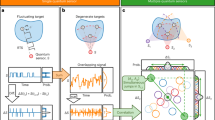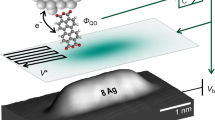Abstract
In the search to develop tools that are able to modify surfaces on the nanometre scale, the use of heavy ions with energies of several tens of MeV is becoming more attractive. Low-energy ions are mostly stopped by nuclei, which causes the energy to be dissipated over a large volume. In the high-energy regime, however, the ions are stopped by electronic excitations1,2,3, and the extremely local (∼10 nm3) nature of the energy deposition leads to the creation of nanosized ‘hillocks’ or nanodots under normal incidence4,5,6. Usually, each nanodot results from the impact of a single ion, and the dots are randomly distributed. Here we demonstrate that multiple, equally spaced dots, each separated by a few tens of nanometres, can be created if a single high-energy xenon ion strikes the surface at a grazing angle. By varying this angle, the number of dots, as well as their spacing, can be controlled.
This is a preview of subscription content, access via your institution
Access options
Subscribe to this journal
Receive 12 print issues and online access
$259.00 per year
only $21.58 per issue
Buy this article
- Purchase on Springer Link
- Instant access to full article PDF
Prices may be subject to local taxes which are calculated during checkout




Similar content being viewed by others
References
Bethe, H. Zur Theorie des Durchgangs schneller Korpuskularstrahlen durch Materie. Ann. Phys. 397, 325–400 (1930).
Bloch, F. Zur Bremsung rasch bewegter Teilchen beim Durchgang durch Materie. Ann. Phys. 408, 285–320 (1933).
Lindhard, J., Scharff, M. & Schiøtt, H. E. Range concepts and heavy ion ranges (Notes on atomic collisions, II). Mat. Fys. Medd. Dan. Vid. Selsk. 33, 1–42 (1963).
Neumann, R. Scanning probe microscopy of ion-irradiated materials. Nucl. Instrum. Methods B 151, 42–55 (1999).
Bouffard, S., Cousty, J., Pennec, Y. & Thibaudau, F. STM and AFM observations of latent tracks. Radiat. Eff. Defects Solids 126, 225–228 (1993).
Khalfaoui, N., Görlich, M., Müller, C., Schleberger, M. & Lebius, H. Latent tracks in CaF2 studied with atomic force microscopy in air and in vacuum. Nucl. Instrum. Methods B 245, 246–249 (2006).
Li, R., Tang, Q., Yin, S. & Sato, T. Plasma catalysis for CO2 decomposition by using different dielectric materials. Fuel Processing Technol. 87, 617–622 (2006).
Thevuthasan, S., Shutthanandan, V. & Zhang, Y. Applications of high energy ion beam techniques in environmental science: Investigation associated with glass and ceramic waste forms. J. Electr. Spectr. Rel. Phen. 150, 195–207 (2006).
Jeon, S., Walker, F. J., Billman, C. A., McKee, R. A. & Hwang, H. Electrical characteristics of epitaxially grown SrTiO3 on silicon for metal–insulator–semiconductor gate dielectric applications. IEEE Electron. Device Lett. 24, 218–220 (2003).
Först, C. J., Ashman, C. R., Schwarz, K. & Blöchl, P. E. The interface between silicon and a high-k oxide. Nature 427, 53–56 (2004).
Brück, S. & Albrecht, J. Experimental evidence of the dominant role of low-angle grain boundaries for the critical current density in epitaxially grown YBa2Cu3O7–δ thin films. Phys. Rev. B 71, 174508 (2005).
Zhang, M. et al. Patterned nanoclusters in the indium-doped SrTiO3 films. Appl. Phys. Lett. 85, 5899–5901 (2004).
Szafraniak, I. et al. Ferroelectric epitaxial nanocrystals obtained by a self-patterning method. Appl. Phys. Lett. 83, 2211–2213 (2003).
Albrecht, J. et al. Surface patterning of SrTiO3 by 30 keV ion irradiation. Surf. Sci. 547, L847–L852 (2003).
Shin, H.-J. et al. Patterning of ferroelectric nanodot arrays using a silicon nitride shadow mask. Appl. Phys. Lett. 87, 113114 (2005).
Ruzmetov, D. et al. Epitaxial magnetic perovskite nanostructures. Adv. Mater. 17, 2869–2872 (2005).
Seitz, F. & Koehler, J. S. Displacement of atoms during irradiation, in Solid State Physics: Advances in Research and Applications 2, (eds Seitz, F. & Turnbull, D. ) 305–448 (1956).
Toulemonde, M., Dufour, C. & Paumier, E. Transient thermal process after a high-energy heavy-ion irradiation of amorphous metals and semiconductors. Phys. Rev. B 46, 14362–14369 (1992).
Morgan, D. V. & Chadderton, L. T. Fission fragment tracks in semiconducting layer structures. Phil. Mag. 17, 1135–1143 (1968).
Fleischer, R. L., Price, P. B. & Walker, R. M. Ion explosion spike mechanism for formation of charged-particle tracks in solids. J. Appl. Phys. 36, 3645–3652 (1965).
Klaumünzer, S. Ion tracks in quartz and vitreous silica. Nucl. Instrum. Methods B 225, 136–153 (2004).
Shima, K., Ishihara, T., Miyoshi, T. & Mikumo, T. Equilibrium charge-state distributions of 35–146-MeV Cu ions behind carbon foils. Phys. Rev. A 28, 2162–2168 (1983).
Shima, K., Kuno, N. & Yamanouchi, M. Systematics of equilibrium charge distributions of ions passing through a carbon foil over the ranges Z = 4–92 and E = 0.02–6 MeV/u. Phys. Rev. A 40, 3557–3570 (1989).
Toulemonde, M., Dufour, C. & Paumier, E. The ion–matter interaction with swift heavy ions in the light of inelastic thermal spike model. Acta Physica Polonica A 109, 311–322 (2006).
Meftah, A. et al. Track formation in SiO2 quartz and the thermal-spike mechanism. Phys. Rev. B 49, 12457–12463 (1994).
Szenes, G. General features of latent track formation in magnetic insulators irradiated with swift heavy ions. Phys. Rev. B 51, 8026–8029 (1995).
Carvalho, A. M. J. F. et al. Discontinuous ion tracks on silicon oxide on silicon surfaces after grazing-angle heavy ion irradiation. Appl. Phys. Lett. 90, 073116 (2007).
Ziegler, J. F. & Biersack, J. P. The stopping and range of ions in matter; http://www.SRIM.org, Version 2003.26.
Horcas, I. et al. A software for scanning probe microscopy and a tool for nanotechnology. Rev. Sci. Instr. 78, 013705 (2007).
The abinit code is a common project of the Université Catholique de Louvain, Corning Incorporated, and other contributors. http://www.abinit.org
Fuchs, M. & Scheffler, M. Ab initio pseudopotentials for electronic structure calculations of poly-atomic systems using density-functional theory. Comput. Phys. Commun. 119, 67–98 (1999).
Perdew, J. P., Burke, K. & Ernzerhof, M. Generalized gradient approximation made simple. Phys. Rev. Lett. 77, 3865–3868 (1996).
Lindhard, J. & Scharff, M. Energy dissipation by ions in the kev region. Phys. Rev. 124, 128–130 (1961).
Acknowledgements
Financial support from the DFG (SFB 616: Energy dissipation at surfaces; and SFB 445: Nanoparticles from the Gas Phase) by GANIL (Project S18), and the sixth framework programme of the EU (EURONS: RII3-CT-2004-506065) is gratefully acknowledged. We thank P. and F. Jeanjean for their help with the experiment and A. Reichert for discussions.
Author information
Authors and Affiliations
Contributions
M.S. and H.L. conceived and designed the experiment. E.A., T.P., M.K., I.M., H.L. and M.S. performed the experiment and analysed and interpreted the data. E.A., R.M. and A.D. performed the theoretical calculations. All authors discussed the results and commented on the manuscript.
Corresponding author
Ethics declarations
Competing interests
The authors declare no competing financial interests.
Rights and permissions
About this article
Cite this article
Akcöltekin, E., Peters, T., Meyer, R. et al. Creation of multiple nanodots by single ions. Nature Nanotech 2, 290–294 (2007). https://doi.org/10.1038/nnano.2007.109
Received:
Accepted:
Published:
Issue Date:
DOI: https://doi.org/10.1038/nnano.2007.109
This article is cited by
-
Graphitic nanostripes in silicon carbide surfaces created by swift heavy ion irradiation
Nature Communications (2014)
-
Energy deposition by heavy ions: Additivity of kinetic and potential energy contributions in hillock formation on CaF2
Scientific Reports (2014)
-
Engineering of nanostructured carbon materials with electron or ion beams
Nature Materials (2007)



